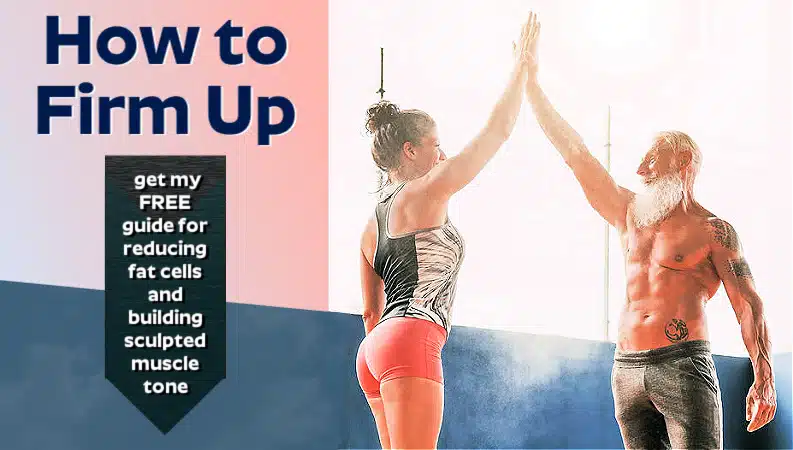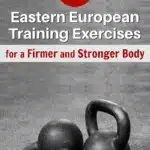Eastern Europe has long been a powerhouse in the world of fitness and strength training. From the legendary weightlifters of the Soviet era to modern-day fitness enthusiasts, Eastern European training methods consistently produce world-class athletes. This article presents eight wildly effective exercises from Eastern Europe that can help you achieve optimal fitness.
I often train at home, so I do modified versions of these exercises with kettlebells on my patio. However, some of these exercises can also be done with barbells. I’ve included a video that should prove helpful.
These exercises can be done anywhere. They’re for all genders and can be modified to match your current skill and strength level.
Get Stronger and Firmer with Eastern European Training Movements
You can experience profound benefits by doing the compound movements found within Eastern European fitness training. Especially when compared to isolated movements commonly performed on modern gym machines.
Compound movements engage multiple muscle groups and joints simultaneously, whereas isolated movements focus on a single muscle group and joint.
There are several reasons why compound movements are often considered more beneficial than isolated movements:
Efficiency: Compound movements allow you to work multiple muscle groups in a single exercise, saving time during your workout. This is especially important in Eastern European fitness training, which often emphasizes functional strength and overall athleticism.
Functional Strength: Many Eastern European fitness philosophies focus on developing strength that applies to real-world activities. Compound movements mimic natural movement patterns and effectively enhance your ability to perform everyday tasks and sports activities.
Muscle Balance and Symmetry: Compound movements promote balanced muscle development by engaging multiple muscles and joints. This can help reduce the risk of muscular imbalances and related injuries.

Hormonal Response: Compound exercises, such as squats, deadlifts, and bench presses, typically involve larger muscle groups and heavy weights. This can lead to a greater hormonal response, including HGH – crucial in muscle tone, good skin and hair, and overall fitness.
Caloric Expenditure: Due to the higher demand for energy and oxygen, compound movements tend to burn more calories during and after the workout, contributing to improved fat loss and metabolism regulation.
Neuromuscular Coordination: Compound movements challenge your neuromuscular system to coordinate multiple muscle groups and joints, improving overall coordination and motor skills.
Joint Stability and Health: Engaging multiple joints in compound movements helps strengthen the stabilizing muscles around those joints, leading to improved joint stability and reduced risk of injury.
Time-Tested Tradition: Eastern European fitness training often draws from traditional practices that have been refined over time. Many of these practices recognize the value of compound movements for building functional strength and durability.
Variety and Mental Stimulation: Compound movements offer various exercises, keeping your workouts exciting and mentally engaging. This can contribute to long-term adherence to your fitness routine.
While compound movements are highly beneficial, it’s important to note that both compound and isolated movements have their place in a well-rounded fitness program. Isolated exercises can target specific muscle weaknesses, address imbalances, or provide recovery-focused workouts.
Try This 8-Exercise Eastern European Strength Circuit
Duration: Perform each exercise for 45 seconds, followed by 15 seconds of rest.
How It Works: Complete the entire circuit, then rest for 1-2 minutes before repeating for a total of 3-4 rounds.
Beginners can stop after 2 rounds. Intermediates can do 3 rounds. And advanced-level athletes can go for the full 4 rounds.
Equipment Needed: Kettlebell, exercise mat, and towel.
Kettlebell Swings (Russia)
The kettlebell, a cast-iron weight resembling a cannonball with a handle, originated in Russia in the 18th century.
Kettlebell swings are full-body exercises that improve cardiovascular fitness, strength, and flexibility. They target the glutes, hamstrings, hips, core, and the stabilizing muscles of the shoulders and back.
To perform a kettlebell swing:
• Stand with your feet hip-width apart, holding the kettlebell with both hands.
• Bend your knees slightly, hinge at the hips, and swing the kettlebell back between your legs.
• Then, drive your hips forward, swinging the kettlebell up to shoulder height.
• Allow the kettlebell to fall back down, using the momentum for the next rep.
In the video, you’ll see I use two kettlebells, then rotate them slightly as they go between my legs. When the kettlebells go up near my head, it’s more of an explosive movement (using the forward thrust of my hips). A common mistake with the kettlebell swing is that many people try to turn it into a front arm raise exercise, but this is actually one of the rare times in resistance training when it’s better to use momentum.
Bulgarian Split Squats (Bulgaria)
Named after the Bulgarian weightlifting team, Bulgarian split squats are unilateral exercises targeting the quadriceps, hamstrings, glutes, and core. They also improve balance and mobility.
Stand in front of a bench or step, facing away:
• Reach one foot back and rest the top of your foot on the bench.
• Bend your front knee to lower your body, keeping your chest up and core tight.
• Push through your front foot to stand back up.
Again, this exercise has variations. For example, if your knees are feeling more sensitive on a particular day, you might choose to place your forward foot farther forward so that your knee is directly over your heel. Conversely, if your knees are feeling good, your front foot placement can be closer – so that when you dip down during the rep, your knee is in front of your heel.

Romanian Deadlifts (Romania)
The Romanian Deadlift is a variation of the traditional deadlift that focuses on the hamstrings and glutes. Romanian weightlifter Nicu Vlad popularized it:
• Stand with your feet hip-width apart, holding a barbell (or kettlebells) before (or beside) your thighs.
• Keeping your back straight and knees slightly bent, hinge at the hips to lower the barbell or kettlebells along your legs.
• Push your hips forward to return to standing.
I encourage you to keep your lower abdominals and glutes super tight during the entire movement. If you relax your lower ab and glute muscles during the movement – even for a second – it will dump all the effort into the lower spine, and injury can result. Go for lighter weight until you get the hang of it.
Russian Twists (Russia)
Russian twists are a core exercise that targets the obliques, abdominals, and lower back. They can be performed with a medicine ball, kettlebell, or weight plate:
• Sit on the floor with your knees bent, feet lifted (or heels barely touching with legs extended a bit more), and a weight in your hands.
• Lean back slightly, keeping your back straight.
• Twist your torso to one side, bringing the weight towards the floor (but it shouldn’t touch the floor). Repeat on the other side.
Polish Press (Poland) from Eastern European Training
The Polish Press, named after Polish weightlifter Szymon Kolecki, is a shoulder exercise that also engages the triceps and upper back.
• Hold a barbell (or a kettlebell in each hand) at shoulder height, palms facing forward.
• Press the bar overhead, then lower it behind your head.
• Press it back up, then lower it to the start.
Personally, for shoulder work, I often prefer to use dumbbells or kettlebells instead of a barbell, so that each shoulder can make any micro-adjustment it needs to during the rep. But if your shoulders are feeling good on a particular day, go ahead and try a barbell – just warm up with lighter weight before going heavier.
Ukrainian Dead Hang (Ukraine)
The Ukrainian Dead Hang is a grip strength and shoulder mobility exercise. Simply hang from a pull-up bar with both hands for as long as possible.
Variations:
• You can allow the rest of your body (other than your forearms and grip) to fully relax and your head looks down a bit. This creates a beautiful traction for your spine and shoulder joints.
• Alternatively, you can do the more active variation, which is to try to keep your shoulders pressed down away from your ears, your scapula engaged, and your pelvis centered.
Serbian Hip Thrust (Serbia)
The Serbian Hip Thrust is a glute-focused exercise that also works the hamstrings and core. It can be performed with a barbell, resistance band, kettlebells resting on the thighs, or even no weight at all:
• Sit on the ground with a bench behind you and a loaded barbell over your hips.
• Lean back against the bench so your shoulder blades are near the top of it.
• Drive your hips up, lifting the barbell by extending your hips, squeezing your glutes at the top.
• Lower your hips back down.
During the movement, keep your chin dropped down toward your chest and your eyes fixed on your abdomen. If you’re using kettlebells like I do in the video, you can form a stable pyramid shape by interlacing your fingers.
Turkish Get-Ups (Turkey) from Eastern European Training
The Turkish Get-Up is a complex, multi-joint exercise that improves strength, stability, and mobility. It involves moving from lying to standing up while holding a weight overhead.
Start by:
• Lying on your back with a kettlebell in one hand, arm extended towards the ceiling.
• Bend the knee on the same side. Roll onto your opposite side, pushing up onto your elbow, then your hand.
• Lift your hips off the ground, then sweep your straight leg back to kneel.
• Stand up, keeping the weight overhead.
• Reverse the movement to return to the start.
As with most exercises, there are many variations and ways to execute the movement (sometimes, I like to try this exercise with the bent knee on the opposite side of my kettlebell arm). What matters most is to keep your eyes on the kettlebell overhead, to keep your working shoulder stable, and your core muscle activated the entire time.
Conclusion on Eastern European Training Exercises
Incorporating a mix of compound and isolated movements into your training regimen can help you achieve a balanced and comprehensive approach to fitness, aligning with the principles often found in Eastern European fitness training philosophies. Check out the video:
Prioritizing proper form, progression, and individualization is wise when designing your exercise routine.
These eight Eastern European training exercises can provide a comprehensive, full-body workout that improves strength, cardiovascular fitness, mobility, and balance.
I encourage you to incorporate them into your training routine for a taste of Eastern European fitness culture – and to take your health to the next level.
